
By David Fox
June 2025 update notes: A further update to this article, a couple of years on from 2023. Cloud storage costs from AWS have remained static, small increases from Wasabi and Backblaze. We’re switching to LTO-9 tapes for our calculations, since they’re now the cheapest cost per TB. LTO-10 has just been announced and full-height drives about to ship. No prices on LTO-10 media at time of writing. LTO-10 drives will not provide any backwards-compatibility with older tape generations.

June 2023 update notes: This updated version of this article, originally published in June 2022 contains updated prices for all cloud storage and LTO storage costs. Archiware P5 Data Mover has also been included since it was released since the original version of the document and is relevant to the topic. Price-wise, cloud storage costs have remained static over the past 12 months, at least for those we’ve used in our comparison. LTO-8 tape media has come down slightly in price and still remains the best cost-per-TB LTO generation, despite LTO-9 having been available since Sept 2021. The cost of our LTO tape library has come down by $500, but we’ve increased our daily LTO hosting costs by $15 to take rising electricity costs into account.
In this article we’ll compare costs and convenience of storing archive data on LTO tapes versus cloud storage from various popular vendors. Many of the articles we’ve read on this topic are published by companies selling cloud storage, so we felt there was an opening for a more balanced analysis. Archiware P5 is a software product supporting both LTO tape and cloud storage and Archiware does not benefit from recommending one type of storage over another.
The article is aimed at media professionals looking to archive their data, often large media files, for long term retention. A typical Archiware P5 user is already doing this, using either LTO tape or cloud storage, but often not clear which is the best choice or whether they should consider switching or using both in a hybrid solution.
Archiware P5 is a software product that manages the archive workflow, by writing files to LTO, cloud or disk storage and tracking which files have been archived. P5 is also able to migrate between different types of storage, or provide redundancy by writing to more than one.
Below we have graphs showing total costs of archiving various quantities of data over a period of 10 years. We show total costs per year, and provide cumulative figures, showing how costs build up over time.
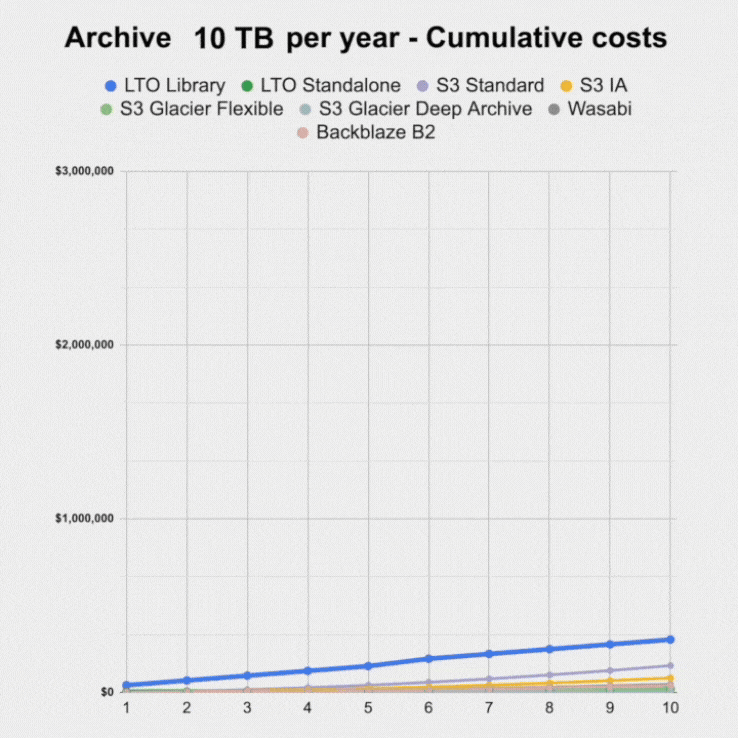
How we costed our comparison
LTO storage costs
Implementing an LTO archive solution is more complex than using cloud storage. A tape workflow requires purchase of hardware, maintenance contracts, providing a building, power, air-conditioning, labour and other factors. Cloud storage simply requires entering payment details and pumping data into the service. Monthly bills account for each GB of data stored, plus some additional charges for download, which vary widely and can be difficult to predict. Cloud’s perceived simplicity alone will convince many that they don’t want to consider tape.
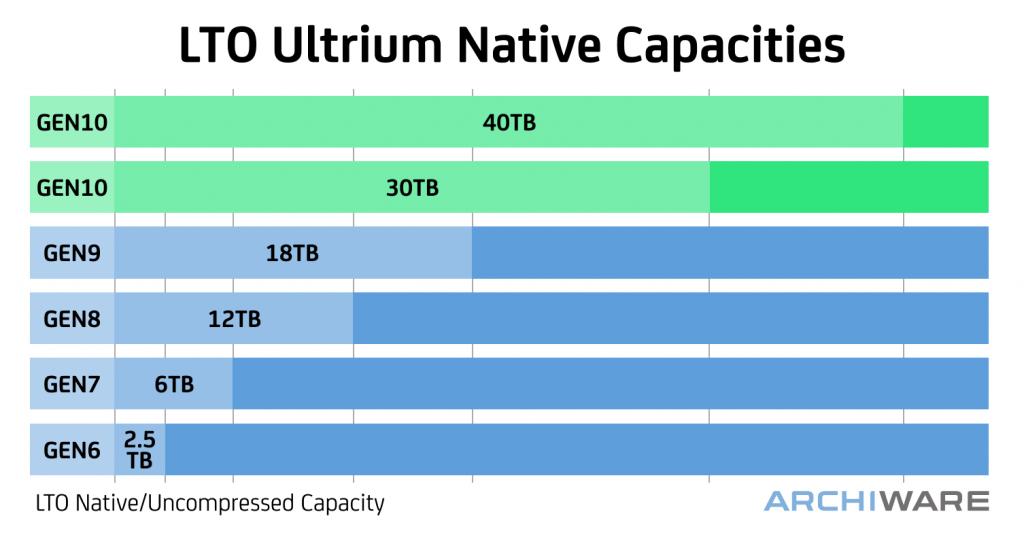
We will begin by describing how we are costing the tape solution. We are providing costs for two different tape solutions in our graphs, a standalone LTO drive and an LTO tape library. The first option is much cheaper and simpler than the second. Let’s examine the differences.
| LTO standalone drive | LTO library | |
| Installation/location | Sits on a desk, next to your workstation, physically like an external hard drive. | Requires mounting in server-racking, with air-conditioning, connecting to server also in rack. |
| Tape management/use | Manual insertion of tapes, one at a time. User swaps tapes when full and inserts tapes required for restores. | Holds 25-80 tapes (typically) automates insertion of tapes for fully automated operation. Tapes can be removed and more added. |
| Cost | $5,000 drive, replaced every 3 years. | $15,000 for LTO library with 25 slots and 2 LTO-9 drives, replaced every 5 years. |
| Tape media cost | Using LTO-9 tapes @ $85 per tape providing 18TB of storage (uncompressed). Write data twice, creating two tapes. | Using LTO-9 tapes @ $85 per tape providing 18TB of storage (uncompressed). Write data twice, creating two tapes. |
| Ongoing annual costs | N/A | $3,700 annually for LTO on-site maintenance contract |
| Ongoing daily costs | N/A | $65 daily for misc costs (server space, power, air-con, staff costs to manage) |
Cloud storage costs
Cloud’s strength lies in simple pricing, although some services are simpler than others. Our pricing comparison is based upon the cloud storage services offered by Amazon Web Services (AWS), Wasabi and Backblaze B2. Google and Microsoft Azure provide similar products. The table below shows storage costs used in our graphs with some remarks about each service’s details. Some of the services reduce pricing slightly depending on the amount of data stored. This has not been taken into account in our calculations for simplicity. Retrieval and API costs are also excluded from our calculations. If data is often recovered from the cloud archive, costs will be higher.
The cost of an internet connection required to use cloud storage is also excluded from our calculations. Most businesses will already have this in place, some will opt for an additional connection just for archive/backup so these tasks don’t impact upon ‘regular’ internet use.
It cannot be stressed enough that costing cloud storage is complex. Even Wasabi, with its ‘no fees for download’ focus, has minimum retention period per object stored, minimum monthly cost and overage costs when downloading more than 100% of what was stored.
The spread of prices in our selected cloud services is broad. The most expensive service, S3 Standard, has many uses beyond archive, it can be used to host content for websites, for example. Storage requirements for archives are largely to upload files and rarely download them. Therefore the cheaper alternatives may provide all that’s needed for this type of workflow.
Price calculators for each service are provided online and highly recommended. Pricing used in table and graphs is for Europe-based storage where available. For large amounts of cloud storage, discounts or arrangements other than pay-as-you-go may be available.
| Summary & URL | TB/Month cost | Retrieval cost | Retrieval speed | |
| S3 Standard | Gold standard for cloud storage, high performance, highest protection from data loss/corruption. Replicated across at least 3 data centres within single ‘region’, e.g. EU Ireland.. Download is chargeable, as are API requests (e.g. file listings), making total costs complex to predict. 26 geographical regions available to choose from. Generally, overkill for archive data. https://aws.amazon.com/s3/pricing/ | $23.00 | Yes | Immediate |
| S3 Infrequent Access | Same as ‘Standard’ except pricing is better tuned for archive data with lower storage costs and higher retrieval costs. Larger minimum object size, 30 day min charged retention per object, per-GB retrieval cost. | $12.50 | Yes | Immediate |
| S3 Glacier Flexible | Glacier purpose-built for archiving, same protection as ‘Standard’ but with 90 day min retention period per object, configurable retrieval times, from minutes to hours, charged accordingly. Additional one-time (API) cost for placing each object into the archive. | $3.60 | Yes | Varies, not immediate |
| S3 Glacier Deep Archive | Same as ‘Glacier Flexible’ with retrieval times up to 12 hours. Higher API cost for placing objects into the archive and retrieving data, 90 day minimum chargeable period (retention) per object stored. Costs over $20 to download 1TB. Only suited when retrieval is mostly unlikely. | $0.99 | Yes | Hours/days |
| Wasabi | Only pay for storage, downloads are free, but downloading more than was uploaded is charged. Minimum 90 day storage charged, per-object. Minimum 1TB storage charged each month. 13 geographical regions available. Shingled Magnetic Recording disks used internally to reduce costs. https://wasabi.com/cloud-storage-pricing/ | $6.99 | No charge for egress/API calls | Immediate |
| Backblaze B2 | Pay for storage, download and API calls. 3 regions available. Cheaper than Wasabi on baseline storage costs, but additional download costs might make it more expensive. https://backblaze.com/b2/cloud-storage-pricing.html | $6.00 | Free egress up to 3x storage | Immediate |
General comparisons
Below we compare LTO tape with Cloud storage across a number of factors we feel relevant to archival.
| LTO Tape | Cloud | |
| Running costs | Higher up-front infrastructure and running costs, lower per-TB/month costs. | Zero up-front costs, pay only for data stored. Pricing can be very complex and difficult to predict. Headline prices don’t tell the whole story. |
| Cumulative storage costs | Once an LTO tape purchased, it holds data at no additional cost for 10+ years | Every TB stored has to be paid for each month, this is the main factor influencing the higher costs over 10 years. |
| Write Speed | LTO-8 and newer, will read/write at 300-400MB/sec, matching and often outpacing source storage. Some latency for moving/swapping tapes, especially with standalone drives. | Dependent upon internet/WAN connection to cloud vendor which should be tested before making assumptions. S3 Glacier requires hours/days to bring data back online before it can be downloaded. |
| Restore Speed | Immediate restore at 300-400MB/sec, provided tapes are available in tape library / drive. | Varies depending upon cloud service being used (e.g. Glacier is slower) and the speed of internet/WAN connection. With fast internet connections, the cloud service could become the bottleneck, bandwidth isn’t unlimited. |
| Air-gap protection against ransomware | Since LTO tapes are discrete and portable cartridges, they can be placed in a secure location, away from devices that can read/write them. This air-gap provides the ultimate protection against unwanted malicious access. | While less easily accessed than an on-line disk, cloud storage is not isolated by an air-gap. Services provide logical equivalents however, such as ‘immutable’ features, whereby written data cannot be deleted within a defined retention period by anyone. |
| Security / Redundancy | Depends on placement of hardware, number of tapes written and storage of tapes. Entirely in the control of the owner. LTO tapes are rated by manufacturers as lasting for 30 years when stored correctly. | Different services provide more/less redundancy across data-centres, all have excellent security generally, including replication of data across multiple data-centres in some cases.. |
| Data ownership | Everything is retained physically within the business, no reliance on third-party corporation terms and conditions or costs and delays to bring data back to physical on-site storage. | Customers retain intellectual ownership, but data is physically remote and can cost money and time to bring back ‘in-house’. |
| Compliance | Internal practices and implementation determine ISO certification of solution. | ‘Built-in’ ISO compliance at no additional cost. The work has already been undertaken by the cloud vendor. |
| Scalability | Standalone LTO drive suitable for archiving around 10-100TB / year, then a library recommended for convenience of speed and operation. Additional storage requires LTO tapes to be purchased. | Scales from a small data-set without limits. Cost breaks available from some vendors as storage increases. |
Cost comparisons
We set up the costs detailed above in a spreadsheet and plot some graphs below showing how costs increase over 10 years with increasing quantities of data being added to the archive each year. Comments are provided against each graph.
You can view and play with the spreadsheet, via Google Docs, here:
https://bit.ly/archiware_storage_pricing_2025
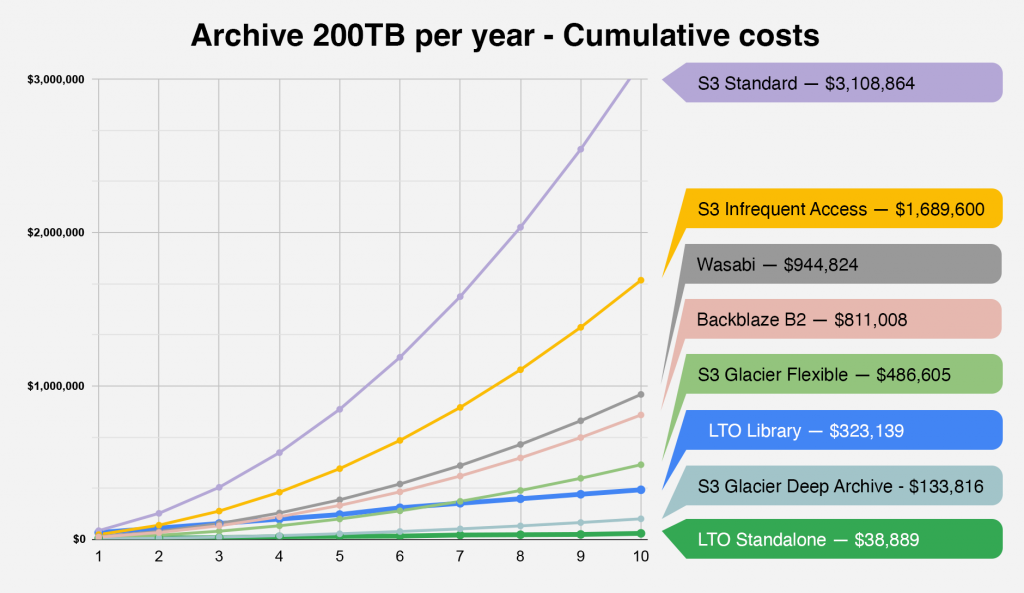
Starting with a large requirement to archive 200TB per year, every year, cloud costs are mostly higher than the LTO Library. The cheapest option is the standalone tape drive, but it would be very inconvenient not to use a tape library with a large quantity of data to archive.
S3 Glacier Deep Archive is the cheapest cloud option by a large margin. Note the exponential shape of the cloud curves, due to having to keep paying for the 200TB archived each year, every year. The LTO curves are relatively flat, because once purchased, a chunk of storage (a tape) only needs to be purchased once within the 10 year time frame.
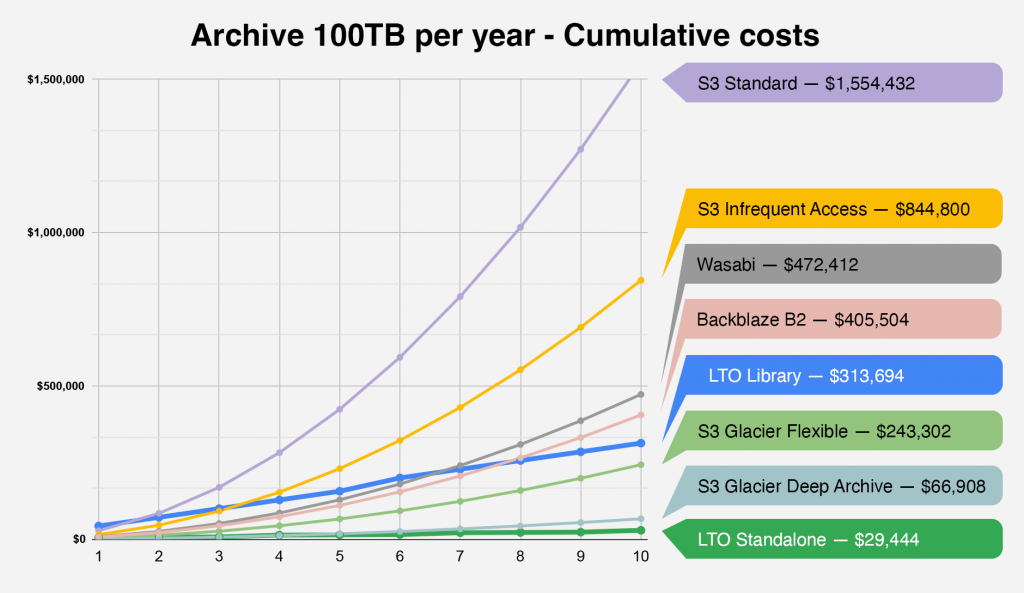
Reducing our archive requirement to 100TB, all but the AWS Glacier cloud storage options are now considerably more expensive than LTO.
S3 Glacier Deep Archive remains competitively priced, albeit access to data stored here is not immediate, and can take days/hours to recover.
Note that S3 Standard now costs over $1,500,000 in total over 10 years with total data-set at 1 Petabyte (PB).
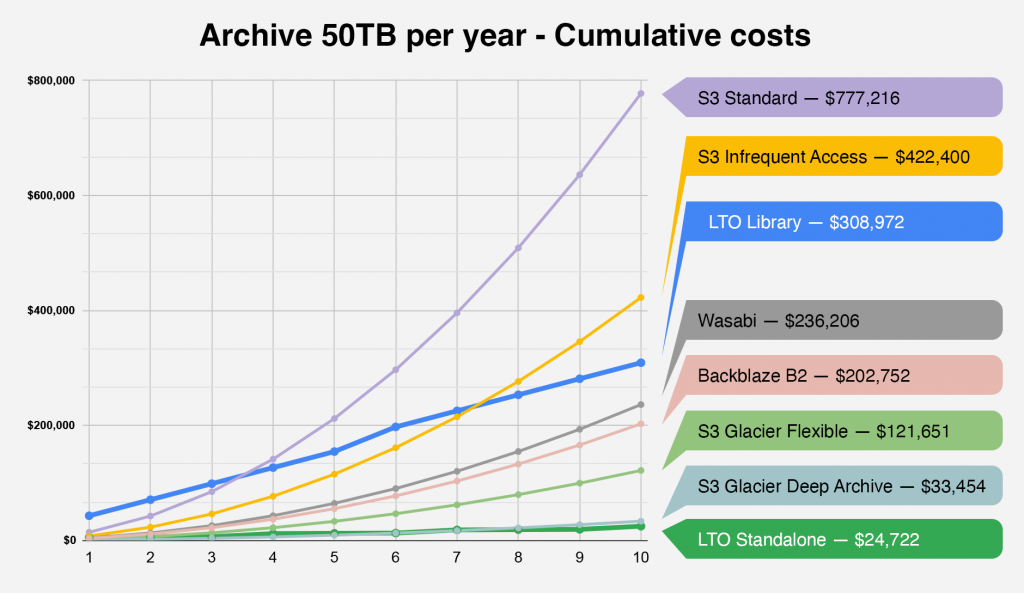
With an archive requirement of 50TB per year, the standalone LTO drive is still cheapest, although convenience of moving tapes manually still a disadvantage. Only 8 LTO-8 tapes per year required, allowing for keeping two copies.
LTO Library is still cheaper than S3 Standard and S3 IA storage. Backblaze and Wasabi now cheaper than the LTO library.
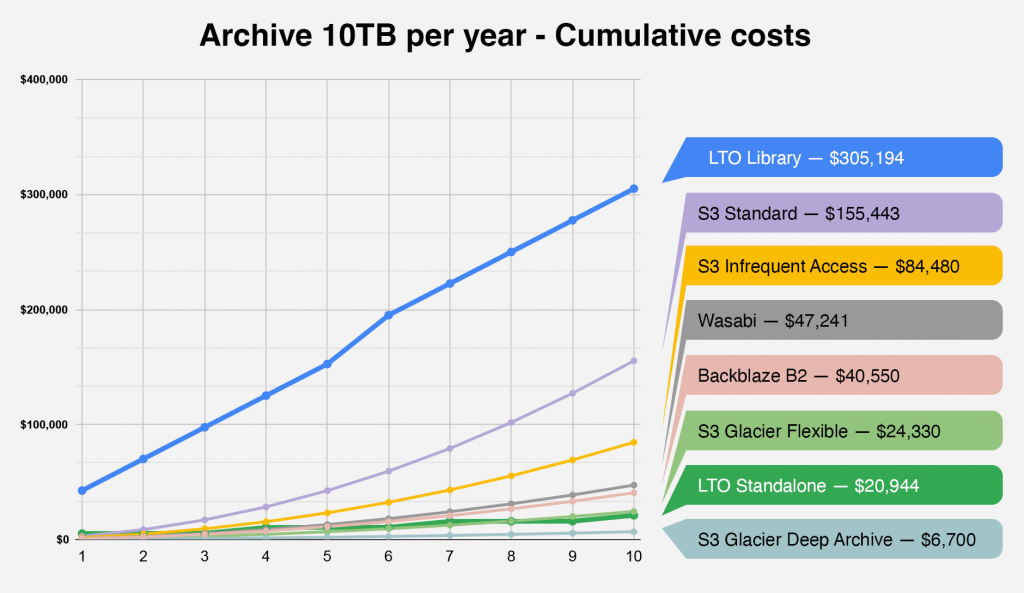
With only 10TB of data to archive per year, the standalone LTO drive becomes the cheapest option over the 10 years as incremental costs of this solution are low.
The LTO library works out the most expensive, due to up-front capital and running costs.
The kinks in the LTO graph lines are created by replacing tape hardware over time.
Conclusions
It’s illuminating to compare costs in this way, although complicated and requiring many assumptions. LTO tape provides high-capacity on-premise storage for those willing to undertake the up-front costs and ongoing management of the solution. LTO is a cost effective storage medium for archive data. An 18TB LTO-9 tape provides storage that only has to be paid for once. Store the tape safely and the data remains in the archive.
Contrast this with 18TB stored in cloud services. Every month the 18TB has to be paid for. These costs accumulate and create increasing costs over time.
However, the cheaper cloud storage options do compete well with LTO tape, even when archiving large data-sets. Glacier Deep Archive, in particular, has an amazing price-point per TB/month, given that Amazon themselves are certainly using tape in their own data-centres to provide storage at this cost. There are caveats with this service (see above) that one should be aware of before proceeding however. One can think of this solution as out-sourcing tape storage.
Backblaze and Wasabi also provide great value storage that competes very well with tape, depending on how much you have to archive.
Archiware P5 Archive software allows archive workflows for both LTO and Cloud, or a combination of both. With the addition of P5 Data Mover, data can be moved or copied between LTO and cloud services after it has been archived. Data may be deleted for migration or duplication based on the date on which it was originally archived. The software can also migrate selectively between one type of storage and another, while keeping everything visible and managed within a web-admin interface.

